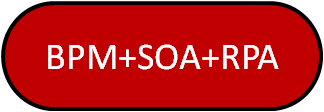I usually see how the term BPM is used in business and technical meetings, mixing meanings. Additionally people use BPM and SOA in the same context but making a big mush of concepts. And finally RPA is the new one at the party.
I would like to make clear this concepts and how both of them are related each other: What BPM is and its relationship with SOA and RPA.
BPM (Business Process Management)
BPM is an enterprise management approach in which organization is seen like a group of business processes. Group of business processes which are managed following a basic Deming 4 phase cycle (PDCA cycle).

Deming 4 phase cycle (PDCA cycle)
We understand business process like the execution of a set of activities designed to create value for the company (i.e for the company clients). In a BPM approach the minimum building unit concept is the business process. It means that we think about business process… we plan, analyze, design, build, delevery, support & monitor… following a Deming PDCA cycle.
It means too that IT and Business Departments’ language are the same, both of them speak business process idiom.
Note: often you can see like, in daily tech meetings, people use “BPM” for referring to “BPM tools”
SOA (Service Oriented Architecture)
A SOA approach is that whose minimum building unit concept is the business service. It means that we think about business services… we plan, analyze, design, build, delivery, support & monitor… following a Deming PDCA cycle.

SOA implementation components
It means that IT and Business Departments’ language are the same, both of them speak business services idiom.
We can understand a business service like the execution of a set of tasks designed to help to complete one o more activities (remember the concept of activity in relation with the business process concept).
RPA (Robotic Process Automation)
RPA focuses on the automation of human tasks using technology, principally software technology running on classic hardware (computers), but in the future news technologies will be added. In this post we are thinking about RPA supported by software technology.
Currently RPA software tools permit the automation of human well known rules and structured data repetitive tasks in front of the screen. So you can quickly build automated processes based on existing ones. It means that you can easily lunch quickwins transforming into digital what before had a human and offline group of actions without impact the rest of the end to end process. (the last can and should be done in the BPM roadmap of the organization)

RPA benefits
So in a quickwin iterative roadmap you can improve quality and decrease activity cycle times by assisting or removing labor in or from activities, cost reduction by eliminating head count or moving employees to greater value tasks.
(you can deepen about RPA by reading “5 RPA Right Principles for Success“)
The Digital Transformation Strategy Advisor’s tips – What BPM is and its relationship with SOA and RPA
So we can say that a SOA and RPA approaches help in a natural way to support the adoption of a BPM approach in an organization. Because of you use (you should) business services and human tasks automation for carrying out a business process.

BPM, SOA and RPA relationship
But you should have in mind that BPM approach goes beyond SOA and RPA approaches (above picture represents this idea). Since business services and Robots represent activities in a business process.
These three model approaches represent a cornerstone in the digital transformation strategy of the big companies because they shape the backbone of the IT services for the core business.

BPM-SOA-RPA approach tips
So if you want to be ready for supporting disruption and innovation you need to create roadmap embracing the best practices of these three approaches. And keep in mind that RPA is an important quickwin starter in this combination.

